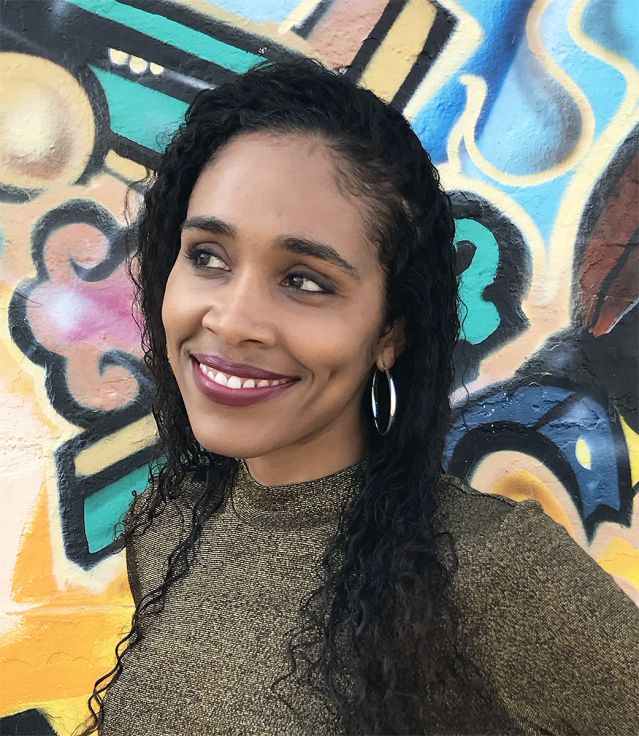Touching The Stars
Astrophysicist and artist Nia Imara draws on art and science to bring the night sky down to Earth.
By Devon Frye published January 3, 2023 - last reviewed on February 17, 2023

In an early self-portrait, Nia Imara sketched herself holding the stars in her hands. Now an artist and a professor of astronomy and astrophysics at UC Santa Cruz, Imara, the first Black woman to earn a Ph.D. in astrophysics from UC Berkeley, is doing just that—creating three-dimensional models, small enough to fit in her palm, of stellar nurseries, the interstellar clouds in which stars are born. It’s just one of the ways she’s working to bring the wonders of the universe to Earth. She also helped spot the first potential planet identified outside the Milky Way and founded a nonprofit, Onaketa, that provides free STEM education to kids of color. She spoke with PT about what we can learn about ourselves by looking to the stars.
How do art and astronomy connect for you?
I paint what I love, and one of the things I love is color. My paintings tend to be filled with bright colors, saturated colors, colors that accentuate the person I’m painting and complement them in unexpected ways. Astronomers are also experts at decoding color. Along with light, color tells us the vast majority of what we know about the universe. We know that blue stars are hotter than red stars, for example; we also know that blue stars are much more massive and tend to have very short life spans compared to red stars, which can shine for billions of years. The sky is incredibly colorful, far beyond what we can see with our human light detectors.
There’s so much of the night sky that humans can’t see. How does your work try to bridge that distance?
I’ve been focusing on stellar nurseries—huge regions of gas and dust that have the potential to form stars—for much of my career. Stars are the visual building blocks of the universe. We know that all of them form in stellar nurseries, and we have beautiful images that show us what these environments look like and allow us to determine the temperature, the presence of magnetic fields, things like that. But these images are flat; they don’t give us any information about the depth or the structure.
Is that where art comes in?
I think so. It offers the power to take something abstract or distant and make it concrete. My collaborators and I have taken everything we’ve learned about stellar nurseries from observations and put the ingredients in a computer simulation that allows us to build nurseries and 3D-print them. They’re little sculptures, in a way—they’re interactive, they’re tangible, and they’re revealing new components of the nurseries’ structure and allowing us to understand them in more nuanced ways.

What challenges does making the intangible tangible present?
Scientists have to make a lot of subjective decisions; the models are a good example of that. We made the aesthetic choice to make the nurseries into spheres, for instance; we could’ve made them in any morphology we wanted because there’s a lot we still don’t know about the shape of these molecular clouds. But in a sense, that’s the definition of what a model is: We’re making choices, we’re simplifying down to what we think is the essence of that thing. We as scientists just need to be transparent about the things we’ve left out, the decisions that we make, the things that we’re unsure of. And as we gain more information and build on our knowledge, we’ll be able to make the models even better. That’s an inherent part of the scientific process.
Even though astronomy is still largely theoretical and remote, you’ve said it’s one of the most powerful tools for engaging the public in science. Why?
Astronomy provokes a childlike curiosity in ways that other sciences often don’t. When people look up at the sky or imagine outer space, it takes them outside of themselves; it allows them to wonder, to imagine. That’s a big part of being human and always has been. I sometimes say that astronomy is the oldest science—for as long as humans have been looking at the sky, they’ve been practicing it in one form or another. In the teachings or mythologies of various cultures, there’s often a story about how people come from the stars or are connected to the stars. With modern astronomy, we know that to be true: We do literally come from the stars.
How are you working toward your goal of wider access to science?
My own experience has helped solidify my understanding that our current educational system has failed and continues to fail far too many children. If so many Black, brown, and poor children are getting an inferior education to begin with, how can we be said to be effectively engaging the public in science? My organization Onaketa, a nonprofit that provides free STEM tutoring for Black and brown youth, is an outgrowth of the education work I’ve been doing for a long time. We’re coming from the position that our children need access to more opportunities. We’re doing what we can for a community that has been, in many ways, failed and left behind.
